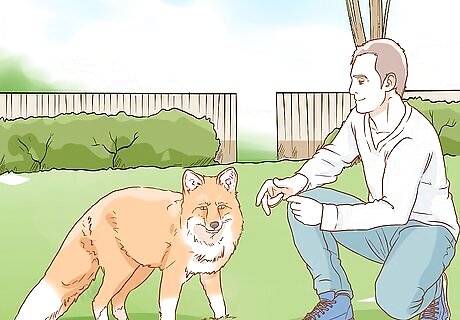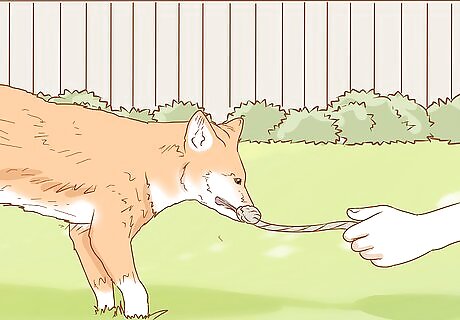
views
X
Research source
It is generally not a great idea to tame a wild fox, but it may be harmless to befriend a fox that ventures near your home. Another option would be to adopt a domesticated fox if it is legal in your state.
Befriending a Wild Fox

Maintain a quiet and welcoming space. Foxes are typically very shy and will be frightened by loud sounds. Never make loud or sudden movements when trying to get a fox to trust you. Remove or disable any motion-activated sprinklers, as this will also scare them away.

Put food out regularly. If there is a fox that visits your property, it may be easy to befriend if you leave out food for it to eat. This will attract them to your yard and keep them coming back. Foxes enjoy fruits and vegetables. This can include cantaloupe, watermelon, honeydew melon, squash, zucchini, sweet potatoes, cooked carrots, beans, and sweet peas. Foxes are omnivores, so you can also feed them raw meat, such as eggs, deer, and fish. Do not feed foxes daily, this might make them lazy and dependent on food from humans. Aim for weekly feedings. Do not leave your house door open and allow wild foxes to feed in your home. This may encourage them to venture into other homes as well. Foxes will also eat dog food, but you should initially stick to the recommended foods above to avoid altering their natural diet. Keep any pets away from the feeding area you make for them. Do not feed the following foods: Grains, chocolate, grapes, raisins, avocados, caffeine, green eggplant, green potatoes, seeds and nuts, peppers, tomatoes, onions, garlic, or junk food.

Avoid getting too close to the fox. Although foxes typically do not attack humans, it is important to remember that they are wild animals, so you can’t always interpret what they’re thinking or how they’re feeling. Never hand feed a wild fox. It is going to have a natural instinct to run away if you attempt to touch or approach it. Never approach a fox with its young offspring, they may attack to protect their young.
Adopting and Training a Domesticated Fox

Find a reputable fox breeder. There are a few organizations around the country that rescue foxes from fur farms and place them for adoption. After completing research about fox ownership laws in your state, you will need to fill out an application to make sure you are qualified to keep a fox as a pet. If your application is accepted, talk to the adoption organization about fox necessities (food, toys, etc.) so you are fully prepared to welcome it into your home.

Contact a vet near you that is willing to treat your fox. Medical care is extremely important. Your job is to locate a vet that has knowledge and experience with foxes, such as a zoo veterinarian. Visit the vet with your fox often, so it gets used to her and not fearful.

Prepare an indoor or outdoor enclosure. A fox should have its own designated space no smaller than 60 square feet. If you choose to have an outdoor enclosure, take precautions so that it won’t escape. The bottom of an outdoor cage should be wire or concrete because foxes are great diggers. Another option is to bury your fox enclosure 3 feet deep so they are not able to dig under it. Make sure their space has access to food and water, a sleeping area, hide box, toys, and a litter box. Foxes also know how to climb, so your cage should have a secure top.

Earn the fox’s trust. It takes patience, consistency, and time for a fox to trust and bond with you. You can do this by talking to them and imitating their sounds. Not all foxes like being touched or petted. Learn their personality and adjust your interactions accordingly.

Socialize your pet fox after 5 days. After adopting your fox, let it get settled in and comfortable with you and your home to avoid stressing it out. If you adopt a baby fox, handle it frequently (but carefully) for proper socialization and to help him get used to you. After about 5 days, slowly introduce your fox to as much as possible so it can be social around other animals and human guests. Keep your fox away from small animals they would normally hunt in the wild, such as rabbits, mice, gerbils, and birds. Dogs and cats are okay as long as you introduce them early on. Foxes are typically very hyper, so play with them for at least an hour daily. Walk your fox twice daily. Once in the morning and the evening should suffice. This will keep them calmer when indoors and prevent them from becoming bored and destructive.

Keep your fox out of trouble by giving them toys to play with. Prevent your fox from getting bored and digging in couch cushions by providing plenty of toys. They will like plushies, ropes, squeaky toys, baby rattles, and some cat toys. Be sure to keep toys away that are not okay to play with. Teach them which items are suitable to play with by spreading a small amount of peanut butter on them and give praise when they play with them.

Train your fox to use a litter box or puppy pad. A fox can be taught to use a litter box just like a cat. To train him, take your fox to the litter box as often as every hour so he can get used to the smell and develop a routine. Because foxes love to dig, try using a litter box that is enclosed to reduce the mess that will result from frequent digging. If it seems that your fox prefers to just dig the box instead of use it as a restroom, try training it on puppy pads. Be sure not to punish your fox by yelling or hitting. They can be very sensitive animals. If your fox has an accident, quickly return her to the litter box or puppy pad to show her the appropriate place to go.

Train your pet fox as you would a dog. Research dog training for basic techniques such as teaching to walk on a leash, sit and play ball or fetch. A fox can be taught to walk on a leash. Help him get used to it by putting a collar on him for a few days before introducing the leash. Make sure the collar is snug enough so he can’t wiggle out. A fox can also be taught to fetch. Play ball with your fox and reward him when he brings it back. This is a great way to bond with your pet.

Redirect poor behavior using a spray bottle. Foxes are very sensitive, so you should never yell at or hit them when they do something wrong. Always keep in mind that they are wild animals, not dogs. Think of it this way: their trust is hard to gain, and very easy to lose. If they are playing with items they are not supposed to or using the bathroom on furniture, use a small spray bottle and give them a gentle spritz of water and firmly tell them “no” without shouting.














Comments
0 comment